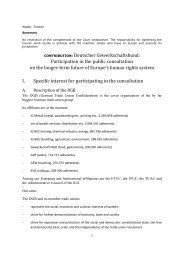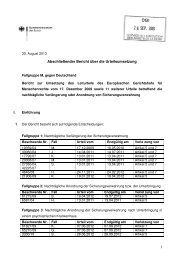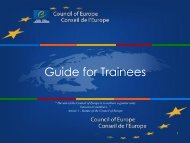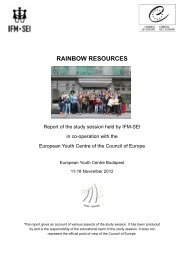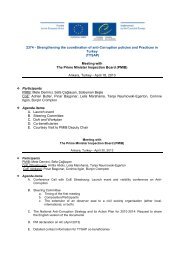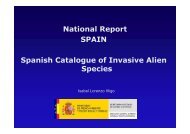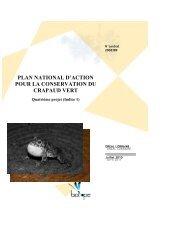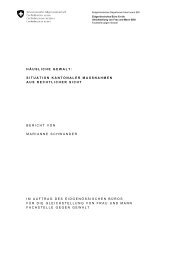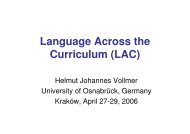Money laundering through money remittance ... - Council of Europe
Money laundering through money remittance ... - Council of Europe
Money laundering through money remittance ... - Council of Europe
You also want an ePaper? Increase the reach of your titles
YUMPU automatically turns print PDFs into web optimized ePapers that Google loves.
<strong>Money</strong> Laundering <strong>through</strong> <strong>Money</strong> Remittance and Currency Exchange Providers - 2010 <br />
CHAPTER II - MONEY LAUNDERING METHODOLOGIES INVOLVING MONEY<br />
REMITTANCE AND CURRENCY EXCHANGE PROVIDERS<br />
58. This chapter describes some <strong>of</strong> ways in which <strong>money</strong> <strong>remittance</strong> and currency exchange<br />
providers have been exploited for ML/TF purposes <strong>through</strong> a series <strong>of</strong> selected case studies provided<br />
by responding jurisdictions. The focus <strong>of</strong> this material is primarily on “traditional” i.e. formal <strong>money</strong><br />
<strong>remittance</strong> and currency exchange providers; however, a few observations have also been included<br />
about informal systems.<br />
59. Generally, these MR/CE providers can be used for <strong>money</strong> <strong>laundering</strong> and terrorist financing<br />
in two ways: either by performing relevant transactions without knowledge <strong>of</strong> the illegal origin or<br />
destination <strong>of</strong> the funds concerned or by a direct involvement <strong>of</strong> the staff/management <strong>of</strong> the provider<br />
<strong>through</strong> complicity or takeover <strong>of</strong> such businesses by the criminal organisation.<br />
60. Several features <strong>of</strong> the MR/CE sectors make them an attractive vehicle <strong>through</strong> which<br />
criminal and terrorist funds can enter the financial system, such as the simplicity and certainty <strong>of</strong><br />
MR/CE transactions, worldwide reach (in case <strong>of</strong> <strong>money</strong> remitters), the cash character <strong>of</strong> transactions,<br />
low-thresholds, the <strong>of</strong>ten less stringent customer identification rules that apply to such transactions<br />
compared with opening bank account and reduced possibilities for verification <strong>of</strong> the customer‟s<br />
identification than in credit or other financial institutions , etc. The nature <strong>of</strong> the customer‟s<br />
relationship with the MR/CE service provider and the brevity <strong>of</strong> contacts is also a significant<br />
vulnerability.<br />
61. <strong>Money</strong> <strong>remittance</strong> providers are used at all stages <strong>of</strong> the <strong>money</strong> <strong>laundering</strong> process. Currency<br />
exchanges specifically are an important link in the <strong>money</strong> <strong>laundering</strong> chain, particularly during the<br />
placement stage. Once the <strong>money</strong> has been exchanged, it is difficult to trace its origin. Also, it has<br />
been noted that considering that they are small businesses, currency exchanges can be easily prone to<br />
takeover by criminals and used to launder <strong>money</strong>.<br />
62. From responses received to the survey questionnaire for this project, the most important<br />
factors that may indicate possible misuse <strong>of</strong> MR/CE service providers:<br />
Use <strong>of</strong> underground <strong>remittance</strong> systems;<br />
Use <strong>of</strong> mules / straw accounts;<br />
Mismatch between the economic activity, country <strong>of</strong> origin, or person and the <strong>money</strong><br />
<strong>remittance</strong>s received;<br />
Periodic transfers made by several people to the same beneficiary or related persons;<br />
Transfers over a short period <strong>of</strong> time <strong>of</strong> low amounts that together represent a large sum<br />
<strong>of</strong> <strong>money</strong>;<br />
Transfers from one or more senders in different countries to a local beneficiary.<br />
Sudden inflow <strong>of</strong> funds in cash followed by sudden outflow <strong>through</strong> financial instruments<br />
such as drafts and cheques;<br />
Structuring <strong>of</strong> transactions and/or changing <strong>of</strong> MR/CE provider for subsequent orders to<br />
keep a low pr<strong>of</strong>ile; and<br />
False information during the identification procedure/lack <strong>of</strong> co-operation.<br />
© 2011 MONEYVAL and FATF/OECD - 21



